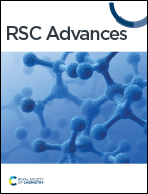A DFT study towards dynamic structures of iron and iron carbide and their effects on the activity of the Fischer–Tropsch process†
Abstract
The Fe-based Fischer–Tropsch synthesis (FTS) catalyst shows a rich phase chemistry under pre-treatment and FTS conditions. The exact structural composition of the active site, whether iron or iron carbide (FeCx), is still controversial. Aiming to obtain an insight into the active sites and their role in affecting FTS activity, the swarm intelligence algorithm is implemented to search for the most stable Fe(100), Fe(110), Fe(210) surfaces with different carbon ratios. Then, ab initio atomistic thermodynamics and Wulffman construction were employed to evaluate the stability of these surfaces at different chemical potentials of carbon. Their FTS reactivity and selectivity were later assessed by semi-quantitative micro-kinetic equations. The results show that stability, reactivity, and selectivity of the iron are all affected by the carbonization process when the carbon ratio increases. Formation of the carbide, a rather natural process under experimental conditions, would moderately increase the turnover frequency (TOF), but both iron and iron carbide are active to the reaction.



 Please wait while we load your content...
Please wait while we load your content...